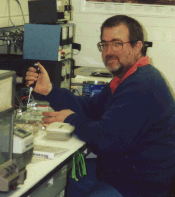
Abstract
This work will collaborate with and extend an ongoing project being conducted by Brookfield Zoo (IL) testing the effects of captive breeding programs on animals’ evolutionary potential. Founders of white-footed mice (Peromyscus leucopus) from Volo Bog (IL) are being bred at Brookfield in three treatments: minimization of inbreeding, selection for docility, and random. Genetic and morphological effects of these treatments will be measured and compared to the wild population. The application of this work is to help determine whether captive-bred stocks are suitable for release in restoration programs, and to help test whether current strategies used in captive breeding programs for conservation do maintain animals that are as evolutionarily fit as possible.
It is crucial to quantify the amount of variation naturally existing in this population, in order to give the Brookfield study a baseline against which to compare changes that occur in captivity. I propose to quantify this background genetic and morphological diversity in the Volo Bog population over the last 100 years. This is possible because an extraordinary series of museum specimens exists, collected from Volo Bog 1903-1999, and falling into five discrete temporal classes. I plan to use two aspects of these museum specimens to quantify diversity: 1) ancient DNA extracted from museum skins and 2) morphometrics using museum skulls. I will compare mitochondrial DNA D-loop sequences from historic and fresh specimens to determine level of genetic diversity. I will use morphometrics and multivariate coefficients of variation to determine degree of morphological diversity. Also, the possibility of rapid morphological evolution, though small, needs to be tested. I will use morphometrics and discriminant function analysis to determine if changes between temporal classes are directional, and therefore corroborative of selection.
